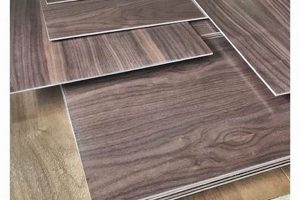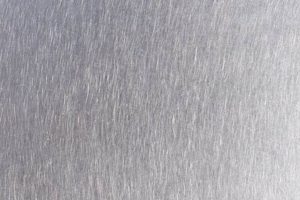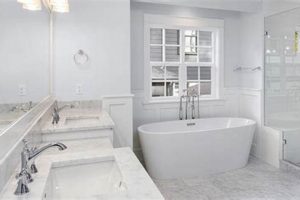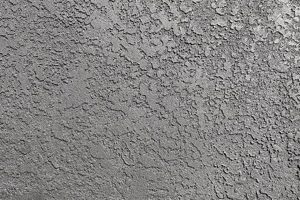The concluding treatments applied to concrete masonry units serve to alter their appearance, enhance their durability, or improve their performance characteristics. These applications can range from simple coatings designed to seal the porous surface to more elaborate surface modifications that impart aesthetic appeal and weather resistance. An example includes the application of stucco to a CMU wall, transforming its raw industrial look into a smooth, paintable surface.
These treatments are critical for several reasons. They protect the underlying blocks from environmental factors like moisture and temperature fluctuations, extending the lifespan of the structure. Furthermore, such applications offer an opportunity to customize the appearance of CMU structures, allowing them to blend seamlessly with surrounding architecture or to achieve a specific design aesthetic. Historically, these techniques have evolved from basic weatherproofing methods to sophisticated architectural features.
The subsequent sections will delve into specific types of surface treatments, focusing on their application processes, advantages, and limitations. The analysis will encompass a range of options, from paint and sealants to more specialized architectural coatings and cladding systems.
Essential Considerations
The following guidelines are presented to optimize the selection and application of materials, ensuring longevity and aesthetic satisfaction.
Tip 1: Surface Preparation: Adequate preparation is paramount. The surface must be clean, dry, and free of any loose debris or efflorescence before any coating is applied. Power washing or sandblasting may be necessary to achieve the optimal surface profile.
Tip 2: Material Compatibility: Verify the compatibility of the chosen material with concrete masonry units. Incompatible products can lead to adhesion failures, discoloration, or accelerated deterioration of the block.
Tip 3: Primer Application: The application of a primer designed for concrete is crucial. Primers enhance adhesion, seal the porous surface, and promote uniform absorption of subsequent coatings.
Tip 4: Moisture Control: Implement measures to control moisture migration. Water infiltration can compromise the integrity of the coating and lead to efflorescence. Consider the use of vapor barriers or breathable coatings in appropriate climates.
Tip 5: Application Technique: Adhere strictly to the manufacturer’s application instructions. Proper mixing ratios, application thicknesses, and curing times are essential for optimal performance.
Tip 6: Environmental Conditions: Consider environmental factors during application. Extreme temperatures or high humidity can negatively impact curing and adhesion. Consult product specifications for recommended application conditions.
Tip 7: Color Selection: Choose colors carefully, considering their long-term fade resistance and their impact on the building’s energy efficiency. Lighter colors reflect more sunlight, reducing heat absorption.
Tip 8: Maintenance Schedule: Establish a regular maintenance schedule to inspect and address any signs of damage or deterioration. Timely repairs can prevent more extensive and costly problems in the future.
Adhering to these guidelines will significantly enhance the performance and appearance of concrete masonry unit structures. Careful planning and execution are essential for achieving long-lasting results.
The concluding section will summarize the key considerations and offer final recommendations for selecting the most appropriate system for specific project requirements.
1. Protection
The protective function of surface treatments applied to concrete masonry units directly influences their long-term performance. Untreated CMUs are susceptible to water penetration, leading to freeze-thaw damage in colder climates. This cycle of freezing and thawing expands the water within the block’s pores, creating internal stresses that cause cracking and disintegration over time. Consequently, an appropriate application acts as a barrier, mitigating water ingress and significantly extending the lifespan of the structure. For instance, the application of a waterproof sealant to a CMU foundation wall prevents hydrostatic pressure from forcing water into the basement, thereby protecting interior finishes and structural integrity.
The type of environmental exposure dictates the level of protection required. Coastal environments, with their high salt content, necessitate specialized coatings resistant to salt-induced corrosion. Industrial areas demand resistance to chemical attack from airborne pollutants. Moreover, the protective layer guards against ultraviolet (UV) degradation, which can cause fading and embrittlement of the concrete. Consider a warehouse situated near a busy highway. Without adequate protection, exhaust fumes and road salts can accelerate the deterioration of the CMU walls, leading to costly repairs. The selection of the appropriate coating, therefore, must consider the specific environmental stressors present at the site.
In summary, the application of surface treatments to concrete masonry units is intrinsically linked to their protection against environmental degradation. This protection translates directly into increased durability, reduced maintenance costs, and extended service life. However, the effectiveness of this protection hinges on the correct selection of materials and application techniques, tailored to the specific exposure conditions. The ongoing challenge lies in balancing cost-effectiveness with the level of protection required, ensuring optimal performance without unnecessary expenditure.
2. Aesthetics
The inherent utilitarian appearance of concrete masonry units often necessitates surface treatments to enhance their aesthetic appeal. The raw, unfinished texture and gray coloration of CMUs are typically unsuitable for architectural contexts demanding visual refinement. Therefore, surface applications play a crucial role in transforming these functional blocks into aesthetically pleasing building components. For instance, applying stucco over CMU walls creates a smooth, textured surface that can be painted or colored to match the surrounding environment, thereby improving the building’s overall appearance. This transformation demonstrates a direct cause-and-effect relationship: the application of an aesthetic treatment directly impacts the visual perception of the CMU structure.
The importance of aesthetics extends beyond mere visual appeal; it influences property value, community perception, and the overall quality of the built environment. A commercial building with exposed, unfinished CMUs may project an image of neglect or cost-cutting, potentially deterring customers or tenants. Conversely, a CMU structure with a well-executed brick veneer or a meticulously applied textured coating can convey a sense of quality and professionalism. Consider a school building where painted CMU walls with colorful murals not only improve the learning environment for students but also enhance the building’s integration with the surrounding neighborhood. These aesthetic enhancements contribute to a positive community image and increased property value.
In summary, aesthetics is an integral component of surface treatments applied to concrete masonry units, transforming them from purely functional elements into visually appealing architectural features. The selection of appropriate materials and application techniques is crucial for achieving the desired aesthetic outcome and realizing the full potential of CMU structures. Overcoming the challenge of integrating CMUs into aesthetically demanding designs requires a comprehensive understanding of available application options and their impact on the overall visual impression of the building. This understanding reinforces the broader theme of balancing functionality and visual appeal in construction and design.
3. Durability
The durability of concrete masonry unit structures is inextricably linked to the surface treatments applied. These applications are not merely aesthetic enhancements; they function as protective barriers against environmental stressors that can compromise the structural integrity of the blocks.
- Water Resistance and Freeze-Thaw Protection
Water infiltration is a primary cause of CMU degradation, particularly in regions with freeze-thaw cycles. Water penetrates the porous structure of untreated blocks, expands upon freezing, and exerts pressure that leads to cracking and spalling. Properly applied sealants and coatings inhibit water absorption, mitigating this damage. For example, applying a silane-based sealer to a CMU retaining wall significantly reduces water penetration, preventing freeze-thaw damage and extending the wall’s lifespan. The implications of failing to address this issue are evident in the deteriorated CMU structures observed in areas with harsh winter climates.
- Resistance to Chemical Attack
Concrete is susceptible to chemical attack from acids, sulfates, and other corrosive substances present in the environment or industrial settings. Certain surface treatments, such as epoxy coatings or chemical-resistant paints, provide a barrier against these agents, preventing degradation of the CMUs. In wastewater treatment plants, for instance, where CMU structures are exposed to corrosive chemicals, specialized coatings are essential for maintaining their structural integrity. The long-term implications of neglecting chemical resistance include structural weakening and potential collapse.
- Protection Against Abrasion and Impact
CMU walls in high-traffic areas or industrial environments are subject to abrasion and impact damage. Durable surface treatments, such as reinforced coatings or cladding systems, enhance the resistance of CMUs to these forces. In loading docks or warehouses, for example, applying a heavy-duty epoxy coating to CMU walls protects them from damage caused by forklifts and other equipment. The lack of such protection results in chipped, cracked, and weakened walls, requiring frequent repairs.
- UV Resistance and Color Stability
Prolonged exposure to ultraviolet (UV) radiation can cause fading and deterioration of certain surface treatments applied to CMUs. UV-resistant coatings and paints maintain their color and integrity over time, preserving the aesthetic appeal of the structure and providing continued protection. For instance, using a UV-resistant acrylic paint on a CMU facade prevents fading and chalking, maintaining the building’s appearance for longer. The consequences of ignoring UV resistance include unsightly discoloration and reduced coating effectiveness.
These facets underscore the crucial role of surface treatments in enhancing the durability of concrete masonry unit structures. The selection of appropriate treatments, based on the specific environmental conditions and performance requirements, is essential for ensuring the long-term integrity and service life of CMU buildings and infrastructure. The successful application and maintenance of these treatments are vital for achieving durable and sustainable CMU construction.
4. Cost-effectiveness
The economic viability of concrete masonry unit (CMU) construction is significantly influenced by the chosen application. While CMUs offer inherent cost advantages due to their relatively low material and labor costs, the final investment is heavily dependent on the surface treatments selected. The interplay between initial cost, long-term maintenance, and expected lifespan determines the overall cost-effectiveness.
- Initial Material and Labor Expenses
The initial cost of various surface treatments varies widely. Simple paint applications represent the lower end of the spectrum, requiring minimal material and labor investment. Conversely, more elaborate options such as stucco, brick veneer, or specialized architectural coatings demand higher upfront expenditures due to increased material costs and the need for skilled labor. For example, a basic paint job on a CMU wall might cost a few dollars per square foot, while a brick veneer could range from ten to twenty dollars per square foot. These initial costs must be weighed against the expected performance and longevity of the application.
- Life Cycle Maintenance and Repair Costs
Long-term maintenance and repair costs are critical components of the overall cost-effectiveness equation. Surface treatments that offer superior durability and resistance to environmental degradation require less frequent maintenance and repairs, resulting in significant savings over the lifespan of the structure. For example, a high-quality elastomeric coating, although initially more expensive than standard paint, may last twice as long and require fewer repairs, ultimately reducing the total cost of ownership. Neglecting this aspect can lead to premature failure and costly remedial work.
- Energy Efficiency and Insulation Value
Certain applications can contribute to improved energy efficiency and reduced heating and cooling costs. Exterior insulation and finish systems (EIFS), for instance, provide enhanced thermal performance, reducing energy consumption and lowering utility bills. While EIFS installations represent a higher initial investment, the long-term energy savings can offset the upfront costs, making them a cost-effective option for buildings in regions with extreme climates. Failure to consider the energy efficiency implications can result in higher operating costs over the building’s lifespan.
- Impact on Building Lifespan and Resale Value
The choice of application influences the overall lifespan of the CMU structure and its potential resale value. Durable, aesthetically pleasing applications can extend the service life of the building and enhance its marketability. A well-maintained CMU building with an attractive and durable facade is more likely to command a higher resale price than a neglected structure with deteriorated or outdated treatments. Therefore, investing in quality applications can be viewed as a long-term investment in the building’s value.
The selection process necessitates a comprehensive analysis of various factors, encompassing material and labor expenses, life cycle maintenance, energy efficiency implications, and the impact on building lifespan and resale value. Balancing these considerations is crucial for maximizing the return on investment and ensuring the long-term cost-effectiveness of CMU construction. Understanding that inexpensive treatments may require frequent replacement while higher-end applications can provide decades of service life is key to maximizing cost savings.
5. Application Complexity
The application of finishes to concrete masonry units (CMUs) involves varying degrees of complexity, impacting both the labor required and the final result. The level of complexity is directly proportional to the desired aesthetic, performance characteristics, and the inherent properties of the CMUs themselves. For instance, a simple coat of paint, while relatively straightforward, may not adequately address the porous nature of CMUs, potentially leading to uneven absorption and a less-than-desirable finish. In contrast, a multi-layered stucco application necessitates meticulous surface preparation, the precise mixing of materials, and skilled troweling techniques to achieve a uniform and durable surface. The choice of application directly influences the required skill level and the time investment, thus affecting the overall cost and project timeline.
Several factors contribute to the complexity of these applications. The surface condition of the CMUs, including variations in texture and the presence of efflorescence, can significantly impact the adhesion and uniformity of the finish. Surface preparation, therefore, becomes a critical step, potentially involving power washing, sandblasting, or the application of specialized primers to ensure proper bonding. Furthermore, the selection of the appropriate application method, whether it be brushing, rolling, spraying, or troweling, depends on the specific material being used and the desired texture. A textured coating applied with a hopper gun, for example, requires careful control of the spray pattern and material viscosity to achieve a consistent and aesthetically pleasing result. The absence of proper planning and execution can lead to issues like inconsistent texture, peeling, or premature failure of the finish.
Understanding the complexities associated with these applications is crucial for both design professionals and contractors. Accurate assessment of the CMU surface, careful selection of materials and methods, and the employment of skilled labor are essential for achieving a successful and long-lasting result. The integration of these considerations into the project planning phase can prevent costly rework and ensure that the final product meets both aesthetic and performance expectations. Recognizing the multifaceted nature of these applications ensures cost-effective and durable solutions for CMU structures.
6. Moisture resistance
The capacity of a surface treatment to impede water penetration is a critical factor in determining the longevity and performance of concrete masonry unit (CMU) structures. This is not merely an aesthetic consideration; moisture ingress can lead to a cascade of detrimental effects, compromising structural integrity and indoor environmental quality. The proper selection and application of surface treatments designed for moisture resistance are, therefore, paramount.
- Prevention of Freeze-Thaw Damage
In colder climates, the cyclical freezing and thawing of water absorbed within CMUs can cause cracking and spalling. The expanding ice exerts pressure on the internal structure of the block, leading to progressive deterioration. Moisture-resistant applications, such as penetrating sealers or elastomeric coatings, create a barrier that minimizes water absorption, effectively mitigating freeze-thaw damage. A parking garage constructed with CMUs, for example, relies heavily on moisture-resistant coatings to withstand the constant exposure to de-icing salts and fluctuating temperatures. Failure to provide adequate moisture resistance in such scenarios can result in significant structural repairs.
- Mitigation of Efflorescence
Efflorescence, the white, powdery deposit that appears on the surface of CMUs, is a direct result of moisture migration. Water dissolves soluble salts within the block, carrying them to the surface where they are deposited as the water evaporates. While efflorescence is primarily an aesthetic issue, its presence indicates ongoing moisture intrusion, which can exacerbate other forms of deterioration. Moisture-resistant applications reduce water movement through the CMU, thereby minimizing the occurrence of efflorescence. A common example is the application of a breathable coating to a CMU garden wall, allowing moisture vapor to escape while preventing liquid water from penetrating the surface.
- Inhibition of Mold and Mildew Growth
Excessive moisture within CMU structures creates a favorable environment for mold and mildew growth. These organisms not only cause unsightly staining and odors but can also pose health risks to building occupants. Moisture-resistant applications prevent water from reaching the interior of the CMU, thereby inhibiting the growth of mold and mildew. A basement wall constructed with CMUs, for example, benefits significantly from a waterproof coating that prevents moisture from seeping in from the surrounding soil. The implications of neglecting moisture control in such environments can range from minor aesthetic issues to serious indoor air quality problems.
- Protection Against Reinforcement Corrosion
In reinforced CMU structures, moisture penetration can lead to corrosion of the steel reinforcement bars embedded within the blocks. This corrosion weakens the bond between the steel and the concrete, compromising the structural integrity of the wall or column. Moisture-resistant applications provide a protective barrier that prevents water and corrosive agents from reaching the reinforcement, thus extending the lifespan of the structure. A bridge pier constructed with reinforced CMUs, for example, relies on specialized coatings to protect the steel from corrosion caused by saltwater and de-icing salts. Failure to provide adequate protection in such critical infrastructure can have catastrophic consequences.
These facets illustrate the multifaceted importance of moisture resistance in relation to concrete masonry unit structures. The selection and application of appropriate finishes that effectively impede water penetration are crucial for ensuring the long-term durability, structural integrity, and indoor environmental quality of CMU buildings. The examples cited underscore the need for a comprehensive approach to moisture management, considering both the material properties of the CMUs and the specific environmental conditions to which they are exposed.
7. Thermal performance
The thermal performance of concrete masonry unit (CMU) structures is significantly influenced by the application of surface treatments. While CMUs possess inherent thermal mass, their insulating properties are relatively limited. Surface applications, therefore, become crucial in modifying the rate of heat transfer through CMU walls, impacting both energy consumption and indoor comfort. A direct cause-and-effect relationship exists: the type of finish applied directly affects the thermal resistance (R-value) of the wall assembly. For example, applying exterior insulation and finish systems (EIFS) significantly increases the R-value of a CMU wall, reducing heat loss in winter and heat gain in summer. The importance of thermal performance as a component of CMU applications lies in its ability to reduce energy costs, improve occupant comfort, and contribute to the overall sustainability of the building.
The selection of appropriate surface treatments must consider the climatic conditions and the desired thermal performance characteristics. In colder climates, exterior insulation is often prioritized to minimize heat loss. In warmer climates, reflective coatings may be employed to reduce solar heat gain. For example, a warehouse in a desert environment may benefit from a reflective roof coating to reduce cooling loads, while a school building in a northern climate may utilize insulated CMU walls to minimize heating costs. The impact extends beyond energy consumption; improved thermal performance can also reduce temperature fluctuations within the building, creating a more stable and comfortable indoor environment. Furthermore, surface treatments can address issues such as thermal bridging, where heat flows rapidly through highly conductive elements, reducing overall thermal efficiency.
The selection of the most suitable application necessitates a comprehensive analysis of various factors, including climate, building orientation, energy costs, and occupant requirements. Balancing thermal performance with other considerations, such as aesthetics, durability, and cost, is crucial for achieving optimal results. Surface treatments are integral to modifying the thermal behavior of CMU structures, and understanding their impact is essential for designing energy-efficient and comfortable buildings. The challenge lies in integrating these treatments effectively, optimizing their performance while minimizing their environmental impact, contributing to broader sustainability goals.
Frequently Asked Questions
The following questions and answers address common concerns and misconceptions regarding surface treatments applied to concrete masonry units. The information presented aims to provide clarity and promote informed decision-making.
Question 1: What is the primary purpose of applying finishes to cinder blocks?
Finishes serve multiple purposes, including enhancing aesthetic appeal, improving weather resistance, increasing durability, and providing a barrier against moisture intrusion. The specific purpose varies depending on the selected finish and the intended application.
Question 2: Are all cinder block finishes suitable for exterior applications?
No. The suitability of a finish for exterior use depends on its ability to withstand environmental factors such as UV radiation, temperature fluctuations, and moisture exposure. Specific products are formulated for exterior applications and should be selected accordingly.
Question 3: How important is surface preparation before applying cinder block finishes?
Surface preparation is critical for ensuring proper adhesion and performance of the finish. The surface must be clean, dry, and free of loose debris, efflorescence, and any existing coatings that may interfere with bonding.
Question 4: What are the long-term maintenance requirements for cinder block finishes?
Maintenance requirements vary depending on the type of finish. Regular inspection for signs of damage or deterioration is essential. Periodic cleaning and reapplication of coatings may be necessary to maintain optimal performance.
Question 5: Can cinder block finishes improve the energy efficiency of a building?
Yes, certain finishes, such as exterior insulation and finish systems (EIFS), can improve the thermal performance of CMU walls, reducing heat loss in winter and heat gain in summer. Reflective coatings can also reduce solar heat gain.
Question 6: What are the common signs of failure in cinder block finishes?
Common signs of failure include cracking, peeling, blistering, fading, efflorescence, and water damage. The presence of these signs indicates that the finish is no longer providing adequate protection and may require repair or replacement.
Careful selection and proper application of cinder block finishes are crucial for achieving long-lasting performance and aesthetic appeal. These FAQs address the core areas of concern for making informed decisions.
The subsequent discussion will address real-world examples and applications, providing practical insights into the use of CMU surface treatments.
Conclusion
The preceding analysis has demonstrated the multifaceted nature of concrete masonry unit surface treatments. Protection, aesthetics, durability, cost-effectiveness, application complexity, moisture resistance, and thermal performance constitute critical decision-making parameters. The selection of appropriate surface treatments directly impacts the longevity, performance, and visual integration of CMU structures within the built environment. A thorough understanding of these elements is essential for informed specification and construction practices.
The diligent application of these principles ensures that CMU construction achieves its potential, offering both economic viability and long-term sustainability. The pursuit of innovation in CMU technology must continue, driven by the dual goals of enhanced performance and reduced environmental impact. Further research and development will be instrumental in expanding the range of surface treatment options and refining existing methodologies to meet the evolving demands of the construction industry. The future of CMU construction hinges on a commitment to excellence in both design and execution.







